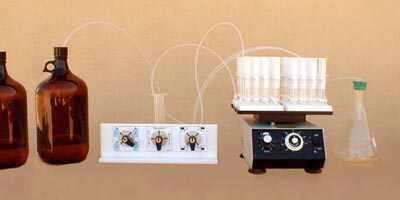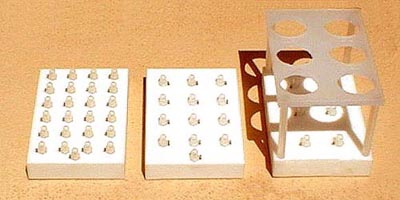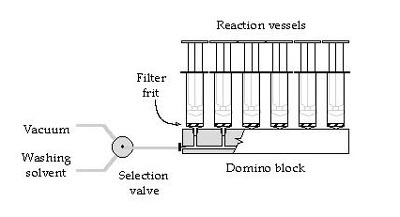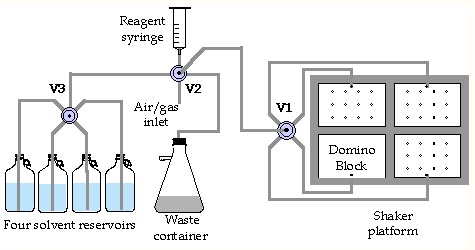|
|

|
|
The Domino Block is Teflon-made liquid distribution manifold (footprint of a standard 96-well plate) that connects all reaction vessels to one common port of a distribution valve. This common port is used to introduce and remove the solvent. Plastic polypropylene syringes equipped with a porous disk at the bottom are used as reaction vessels. The syringes, charged with resin, are attached via a male Luer fitting to the Domino Block arrayed with a female Luer lock fittings. Three different Domino Blocks are available. Domino Blocks for 24 syringes (4 rows of 6 syringes) accommodate 2.5 and 5 mL syringes, Domino Blocks for 12 syringes (3 rows of 4 syringes) accommodate syringe size up to 20 mL amd Domino Blocks for 6 syringes (2 rows of 3 syringes) designed for 50 mL syringes. This Domino Block has a special holder to prevent losing syringes during shaking. |

|
|
The concept of liquid exchange is based on a simple principle. At first, a single outlet reaction vessels (e.g. a plastic syringes), loaded with resin, are connected to an evacuated waste container. The difference in pressure between the reaction vessel (atmospheric pressure) and the evacuated waste container draws the liquid from the reaction vessel into the waste container and creates a vacuum inside the reaction vessel. The evacuated reaction vessels are then connected to a solvent reservoir. The pressure difference causes the evacuated reaction vessels to be filled with the solvent from the reservoir. The role of the Domino Block is to enable the liquid exchange in a number of reaction vessels at the same time. |

|
|
The Domino Block synthesizer with
four Domino Blocks is shown in the cartoon. To operate four Domino
Blocks at the same time, common ports of 4-port distribution
valves V1 and V2 were connected.
Four ports of the Domino Block selection valve V1 were
connected to four Domino Blocks. Four Domino Blocks were placed on a
Titer-plate shaker (Lab-Line Instruments) that provided adequate mixing of
the the resin in reaction vessels. One port of the distribution valve
V2 was connected to the evacuated waste container, and the
opposite port was connected to the common port of valve
V3. Four ports of this valve were connected to
four solvent reservoirs. |
Then the valve V2
was turned to the Solvent position. Domino
Block was connected with one of the solvent containers. The
evacuated reaction vessels were filled with this solvent. |
|
|
